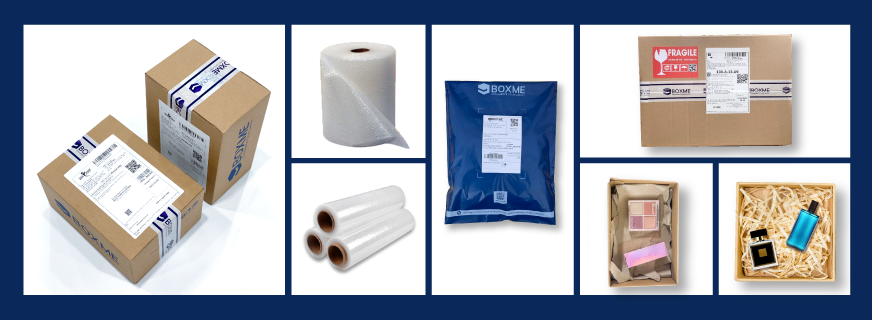Boxme applies standardized packaging guidelines for all shipments from its warehouses to ensure product safety and minimize risks of damage during transportation.
Packing Materials Used #
- Boxme-branded bags / Seller-branded bags
- 3-5 layer carton boxes (Boxme or Seller branding)
- Fragile tape or Boxme Logo tape
- Kraft paper
- Bubble wrap (for shock absorption)
- White PE shrink film
- Fragile warning labels
- Special protective materials (e.g., shredded paper, etc.)

Packaging Material Standards #
- Eco-friendly materials: Biodegradable and sustainable, limiting plastic usage.
- New and branded packaging: Only unused bags and boxes with Boxme/Seller branding are used.
- Bubble wrap selection:
Large bubble wrap for home appliances & electronics (e.g., cookers, irons, grills).
Small bubble wrap for cosmetics, food, and fashion items for better cushioning.
- Kraft paper: is a material used to insert into boxes so that there are no gaps that cause the goods inside the box to shift and collide. There are 2 types of kraft paper: Thick & rigid for electronics and home appliances products, Soft & thin for cosmetics and food products.
- PE shrink film: Used for sealing bulk shipments; specific products based on requirement or moisture-sensitive goods.
- Printing label (for shipping label): size 10x15cm.
- Barcode label: size 5×2,5cm.
- Boxme-branded tape: Standard use for sealing orders.
- Fragile warning tape: Applied for fragile items that requested caution from courier. If customers don’t select fragile warning labels, Boxme will use Boxme-branded tape.
- Fragile warning labels: Applied upon customer request.
Packing Guidelines #
- Liquid Products & Cosmetics
- Wrapped 2-3 layers with bubble wrap
- Placed products neatly inside boxes
- Liquid/gel products: re-inforce properly upon warehouse entry.
- Upright packaging to prevent leaks.
- After the goods have been carefully reinforced according to requirements, the packing staff will place them in cartons and use paper to fill the gaps between the products so that they will not be displaced or broken during transportation.
- Electronics & Home Appliances
- Fragility assessment and re-inforce upon warehouse entry.
- 2-3 layers of large bubble wrap for protection.
- Shock-absorbing materials (foam/mats) must be used for products inside boxes.
- Orientation labels (e.g., “This Side Up”) applied.
- Sealed in Boxme or manufacturer boxes, with fragile warnings and shipping labels.
- Fragile Items (Glass, Ceramics, Carbonated Drinks)
- Each item individually bubble-wrapped.
- Using kraft paper, bubble wrap for separation.
- Carefully stacked inside boxes.
- Fragile warning labels applied externally.
- Boxes filled with cushioning material to eliminate gaps and movement., sealing by Fragile warning tape and fragile warning label near to shipping label.
- Fashion Products (Bags, Shoes, Clothing)
- Clothing must be sealed in plastic before warehouse storage.
- Shoes must be unboxed under surveillance camera to verify contents.
- Bags & wallets must be bubble-wrapped to prevent scratches.
- Packaged in bags or boxes (Boxme logo or branded logo), then sealed with Boxme tape to prevent tampering or loss.
- Other normal products (Books, accessories)
- Books must be wrapped in plastic bags to prevent dust exposure.
- Books can be bubble wrapped to prevent curling of edges and spines, then packed in a box that is not too large to ensure that the books are not crumpled or damaged during transportation.
- Bulky & Heavy Items
- PE film wrapping to protect from dust and moisture
- Loading/unloading using specialized equipment to avoid the risk of dents and damage to goods.





